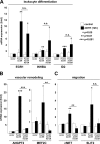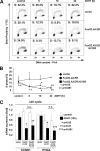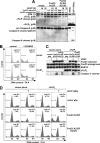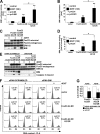FOXO3 modulates endothelial gene expression and function by classical and alternative mechanisms
- PMID: 20123982
- PMCID: PMC2856222
- DOI: 10.1074/jbc.M109.056663
FOXO3 modulates endothelial gene expression and function by classical and alternative mechanisms
Abstract
FOXO transcription factors represent targets of the phosphatidylinositol 3-kinase/protein kinase B survival pathway controlling important biological processes, such as cell cycle progression, apoptosis, vascular remodeling, stress responses, and metabolism. Recent studies suggested the existence of alternative mechanisms of FOXO-dependent gene expression beyond classical binding to a FOXO-responsive DNA-binding element (FRE). Here we analyzed the relative contribution of those mechanisms to vascular function by comparing the transcriptional and cellular responses to conditional activation of FOXO3 and a corresponding FRE-binding mutant in human primary endothelial cells. We demonstrate that FOXO3 controls expression of vascular remodeling genes in an FRE-dependent manner. In contrast, FOXO3-induced cell cycle arrest and apoptosis occurs independently of FRE binding, albeit FRE-dependent gene expression augments the proapoptotic response. These findings are supported by bioinformatical analysis, which revealed a statistical overrepresentation of cell cycle regulators and apoptosis-related genes in the group of co-regulated genes. Molecular analysis of FOXO3-induced endothelial apoptosis excluded modulators of the extrinsic death receptor pathway and demonstrated important roles for the BCL-2 family members BIM and NOXA in this process. Although NOXA essentially contributed to FRE-dependent apoptosis, BIM was effectively induced in the absence of FRE-binding, and small interfering RNA-mediated BIM depletion could rescue apoptosis induced by both FOXO3 mutants. These data suggest BIM as a critical cell type-specific mediator of FOXO3-induced endothelial apoptosis, whereas NOXA functions as an amplifying factor. Our study provides the first comprehensive analysis of alternatively regulated FOXO3 targets in relevant primary cells and underscores the importance of such genes for endothelial function and integrity.
Figures







Similar articles
-
Runx1 is a co-activator with FOXO3 to mediate transforming growth factor beta (TGFbeta)-induced Bim transcription in hepatic cells.J Biol Chem. 2009 Jul 24;284(30):20227-39. doi: 10.1074/jbc.M109.027201. Epub 2009 Jun 3. J Biol Chem. 2009. PMID: 19494111 Free PMC article.
-
FoxO proteins' nuclear retention and BH3-only protein Bim induction evoke mitochondrial dysfunction-mediated apoptosis in berberine-treated HepG2 cells.Free Radic Biol Med. 2014 Nov;76:185-99. doi: 10.1016/j.freeradbiomed.2014.07.039. Epub 2014 Aug 13. Free Radic Biol Med. 2014. PMID: 25128467
-
FKHRL1-mediated expression of Noxa and Bim induces apoptosis via the mitochondria in neuroblastoma cells.Cell Death Differ. 2007 Mar;14(3):534-47. doi: 10.1038/sj.cdd.4402017. Epub 2006 Aug 4. Cell Death Differ. 2007. PMID: 16888645
-
The rules and regulatory mechanisms of FOXO3 on inflammation, metabolism, cell death and aging in hosts.Life Sci. 2023 Sep 1;328:121877. doi: 10.1016/j.lfs.2023.121877. Epub 2023 Jun 22. Life Sci. 2023. PMID: 37352918 Review.
-
Molecular regulation and function of FoxO3 in chronic kidney disease.Curr Opin Nephrol Hypertens. 2020 Jul;29(4):439-445. doi: 10.1097/MNH.0000000000000616. Curr Opin Nephrol Hypertens. 2020. PMID: 32427691 Free PMC article. Review.
Cited by
-
The PAX3-FOXO1 fusion protein present in rhabdomyosarcoma interferes with normal FOXO activity and the TGF-β pathway.PLoS One. 2015 Mar 25;10(3):e0121474. doi: 10.1371/journal.pone.0121474. eCollection 2015. PLoS One. 2015. PMID: 25806826 Free PMC article.
-
Neutrophil oxidative stress mediates obesity-associated vascular dysfunction and metastatic transmigration.Nat Cancer. 2021 May;2(5):545-562. doi: 10.1038/s43018-021-00194-9. Epub 2021 May 3. Nat Cancer. 2021. PMID: 35122017
-
The FOXO's Advantages of Being a Family: Considerations on Function and Evolution.Cells. 2020 Mar 24;9(3):787. doi: 10.3390/cells9030787. Cells. 2020. PMID: 32214027 Free PMC article. Review.
-
Crucial role for human Toll-like receptor 4 in the development of contact allergy to nickel.Nat Immunol. 2010 Sep;11(9):814-9. doi: 10.1038/ni.1919. Epub 2010 Aug 15. Nat Immunol. 2010. PMID: 20711192
-
Endothelial cell apoptosis in angiogenesis and vessel regression.Cell Mol Life Sci. 2017 Dec;74(24):4387-4403. doi: 10.1007/s00018-017-2577-y. Epub 2017 Jun 23. Cell Mol Life Sci. 2017. PMID: 28646366 Free PMC article. Review.
References
-
- Greer E. L., Brunet A. (2005) Oncogene 24, 7410–7425 - PubMed
-
- Dansen T. B., Burgering B. M. (2008) Trends Cell Biol. 18, 421–429 - PubMed
-
- Ogg S., Paradis S., Gottlieb S., Patterson G. I., Lee L., Tissenbaum H. A., Ruvkun G. (1997) Nature 389, 994–999 - PubMed
-
- Lee S. S., Kennedy S., Tolonen A. C., Ruvkun G. (2003) Science 300, 644–647 - PubMed
-
- Medema R. H., Kops G. J., Bos J. L., Burgering B. M. (2000) Nature 404, 782–787 - PubMed
Publication types
MeSH terms
Substances
LinkOut - more resources
Full Text Sources
Other Literature Sources
Molecular Biology Databases
Research Materials

